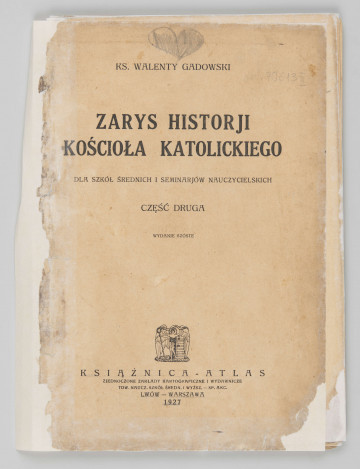
Outline of the history of the Catholic Church for secondary schools and teachers’ schools
1927
National Museum in Lublin
Part of the collection: Craft and industry products of Szczecin
At the end of the 19th and in the early 20th century, many general and specialised schools were established in Szczecin, including the renowned Municipal School of Crafts and Artistic Industry. However, the absence of a higher education institution was a disadvantage for the local intellectual and academic community. This situation changed only after World War II, when Polish educational structures began to develop in what had until recently been a German city. In the autumn of 1946, the first higher education institution in Szczecin’s history – the Academy of Commerce (Akademia Handlowa) – was established, operating from 1946 to 1955. The first academic year was inaugurated on 14 October, National Education Day. The institution operated as a branch of the then-private Academy of Commerce in Poznań. The first rector was Professor Leon Babiński (1891–1973), a civil law specialist educated in Paris and Moscow, and an expert in international maritime and aviation law. In 1950, the now nationalised and independent institution was renamed the Higher School of Economics in Szczecin (Wyższa Szkoła Ekonomiczna). Five years later, it merged with the School of Engineering to form the Faculty of Engineering and Economic Road Transport of the Szczecin University of Technology, which in 1985 became the core of two economic faculties of the University of Szczecin. The first Szczecin students wore distinctive, round caps with small visors, modeled on the green caps of the Academy of Commerce in Poznań. On the crown, the caps featured a Mercury’s caduceus, embroidered in yellow thread – a staff symbolising peace and commerce, topped with a pair of wings and entwined by two serpents facing each other, representing wisdom and balance of power. The presented cap was donated to the Museum of the History of Szczecin by the family of Wacław Grzywacz, a student of Szczecin’s first higher education institution. Małgorzata Peszko
Author / creator
Object type
headgear, cap (headgear)
Technique
machine sewing, hand sewing, wyszywanie, craft production
Material
velvet, plastic, fabric
Origin / acquisition method
donation
Creation time / dating
Creation / finding place
Owner
The National Museum in Szczecin
Identification number
Location / status

1927
National Museum in Lublin

1924
National Museum in Lublin

1918 — 1939
National Museum in Lublin
DISCOVER this TOPIC
Museum of King Jan III's Palace at Wilanów
DISCOVER this PATH
Educational path